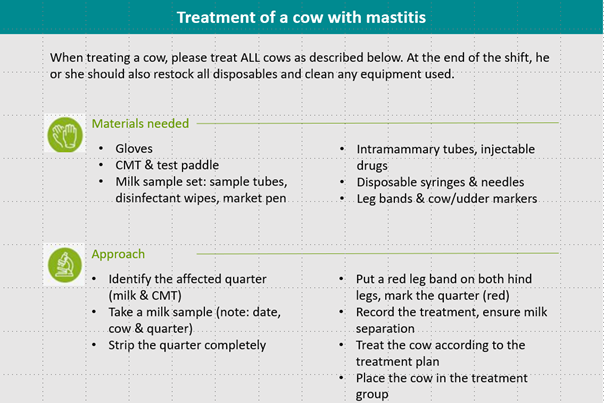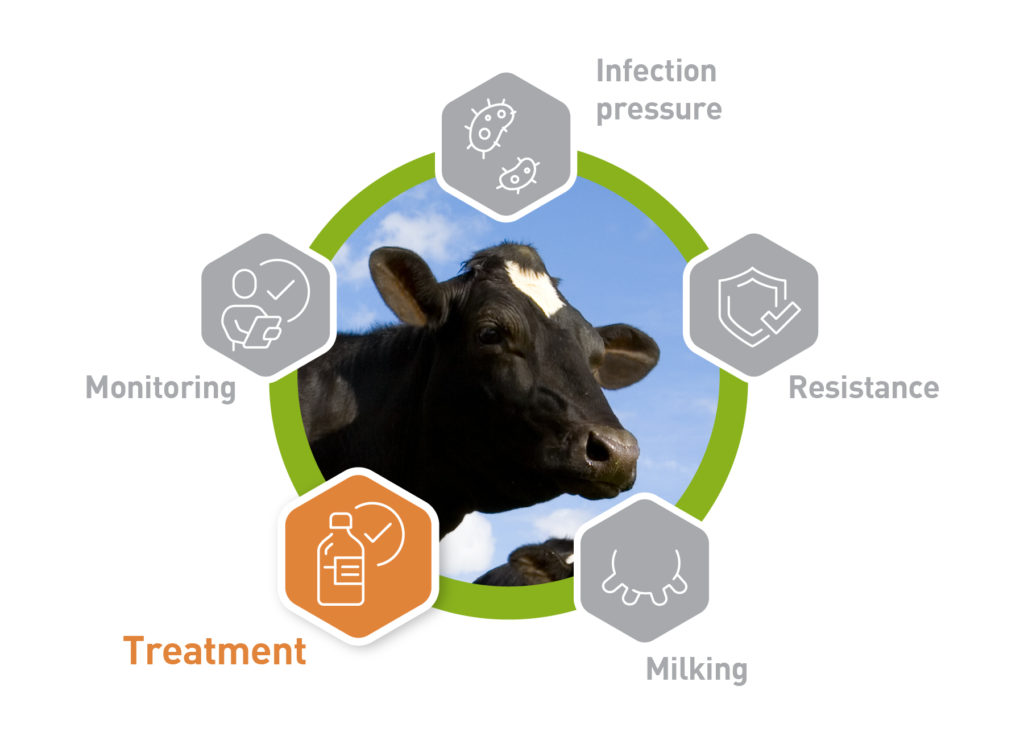
For farmers and farm workers treatment plans provide guidance for the right approach to sick cows, for example how to deal with a cow with clinical mastitis.
They also reduce the risk of giving the wrong treatment or the wrong dosage – or treating when it is not necessary. When farmers know exactly what to do, treatment results improve.
A farm treatment plan is a list that specifies the optimal treatment for specific health problems, tailor-made for each farm.
Treatment of a health problem consists of two main components:
- Good nursing care
Providing good care to the animal, making sure it is comfortable, and well fed and watered until it is completely healthy again. Although farm treatment plans usually focus on medical treatment, good nursing care is an essential part of health care.
- Medical treatment
Which medication should be administered when, how should it be given and for how long? What are the milk and meat withdrawal times?
Teach your clients how to inject medication correctly and hygienically [Injection instruction card]
When setting up treatment plans, consider the following:
- Veterinary input is essential: how you can help
- Advice, training and monitoring
- Protocols for treatment plans: the case of mastitis
Veterinary input is essential: how you can help
Farm treatment plans should always be set up by the farm veterinarians. Veterinary expertise is needed to decide which treatment should be applied. Good prior knowledge of the farm is key for a successful farm treatment plan. This includes:
- Knowledge of the animal health status
Based on the clinical history of the farm, you as veterinarian should have a good picture of which species or group of bacteria is most likely to cause clinical mastitis on a specific farm. You should also assess the infection pressure and whether the possibility of antimicrobial resistance should be taken into account.
- Knowledge of how the farm works
The choice of the optimal first treatment depends on how the farm is set up. On farms with milk robots, giving intramammary treatments require more work than on farms with a milking parlour. Some farms with milking parlours will allow milkers to give treatment during milking, while on other farms this is done separately by an appointed farm worker. This will have an influence on the treatment plan.
- Involving the farmer and farm workers
As the farmer or the farm workers will often give the treatments, you need to know the capability of the farmer and the farm workers. They should be trained and coached, and the treatment plans should be adjusted accordingly.
Teach your clients how to inject medication correctly and hygienically [Injection instruction card]
When in doubt, “call the vet”!
Each farm treatment plan should have an option: ‘call the vet’. The stage at which this applies will differ per farm. Some farmers prefer to rely on their vet, while others want to be capable of providing the treatment themselves.
Advice, training and monitoring
When presenting the farm treatment plan to the farmer, it is an excellent opportunity to discuss all the aspects of treatment:
- Which medicines the farmer should have in stock, and what quantity
- Correct storage of medication and instruments;
- How medication should be applied and what materials is required, e.g.
- Intramammary tubes: gloves, disinfectants, teat dip;
- Intramuscular and subcutaneous injections: needles, syringes, storage, disposal of sharps;
Teach your clients how to inject medication correctly and hygienically [Injection instruction card]
- Administration of treatments. Practise the application of medicines with the farmer to ensure it is done safely and effectively
- How to be sure (doubly sure!) milk from treated animals is separated
- Setting up a smart system for marking cows
- Setting up a simple system for communication, such as the use of message boards
- Setting up a system of monitoring treatment results per cow, and udder health plus mastitis pathogen status at farm level.
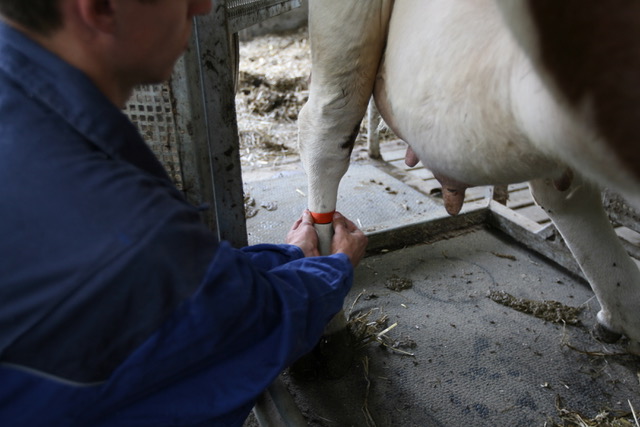
Some farmers can be uncertain about giving treatments and are very happy when their vets take the time to train, coach and support them.
Inserting an intramammary tube [Instruction card for infusing the udder]
Giving an intramuscular injection [Injection instruction card]
Taking a milk sample [Milk sampling instruction card]
Protocols for farm treatment plans – the case of mastitis
Like all farm treatment plan, the plan for how to deal with clinical mastitis must answer the question ‘what should I do and when?’-
This question will most likely pop up in the milking parlour. It is therefore essential to use observations that milkers can make and specify them, to define categories of clinical mastitis. For example, the milker can observe the milk, swelling of the udder, painfulness of the udder and milk production. They can observe her demeanour: is she lively and attentive, or dull and absent?
The milker can also take the body temperature of the cow. This should be the first step after noting that the milk is abnormal.
The number of categories a farm treatment plan gets, largely depends on the number of treatments the milker can give. But, as a general rule: create as few categories as possible and no more than four for clinical mastitis. 99% of farms only need three or four categories.
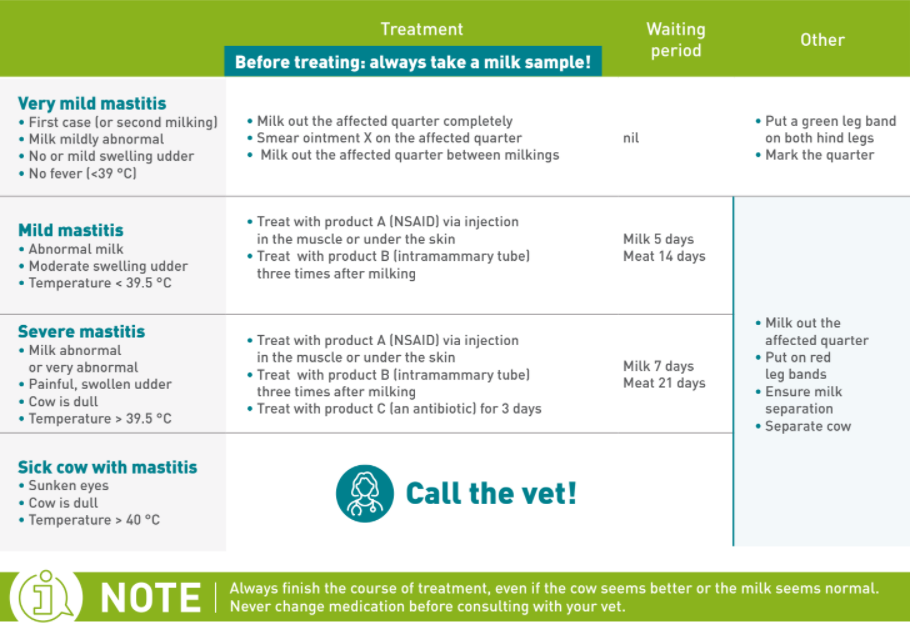
Further explanation, insights and training should be presented separately, for instance during an instruction session hosted by the farm vet.
Flagging ‘repeat offenders’
Cows with chronic “very mild mastitis” should be flagged. If they are still showing signs of very mild mastitis after three subsequent milkings, the milker should now treat them as “mild mastitis”. This means taking a milk sample, ensure milk separation, treat according to the treatment plan as described for mild mastitis.
Visually this means:

Another approach is as follows:
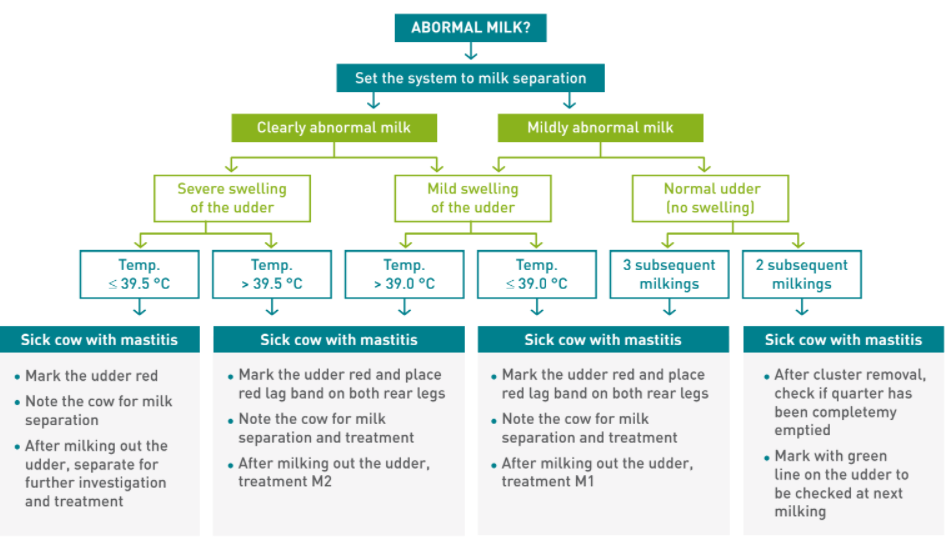
Treatment plans should be set up in close collaboration with the farmer and be adapted to his farm and circumstances.
For more information, see: Is the treatment plan working? [future blog]
Detailed treatment protocols are welcomed by the farmer and the milkers: everyone knows exactly what to do. As vets, you can also advise them on this.
